/cdn.vox-cdn.com/uploads/chorus_image/image/38832550/20101014-Pizza_20Lede1.0.jpg)
[All photos by Nick Solares]
Although New York City has long had a clearly defined and ubiquitous style of pizza, the city's appetite for the dish knows no bounds. While New Yorkers can certainly be parochial and protective of their home slice, they can also be open and accepting of different pizza points of view. Here is a look at the predominant forms of pizza found in New York City with information about how they developed over the years, and a glimpse at some of the more eclectic and disparate variations on the theme.
Neapolitan-American Pizza: The Original NY Pie
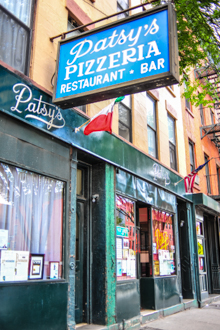 The story of pizza in America begins in New York City in 1905 with Gennaro Lombardi, who began selling pizza out of his grocery store on Spring Street for the princely sum of a nickel per pie. The recipe had likely been handed down through the generations of the Lombardi family and adapted using local ingredients and cooking methods resulting in a form of pizza inspired, but distinct, from the original pizza of Naples. Pizza had unquestionably existed in America prior to 1905, but it did so in the domestic environment of the kitchens of Italian immigrants. Lombardi scaled this up to meet commercial demands.
The story of pizza in America begins in New York City in 1905 with Gennaro Lombardi, who began selling pizza out of his grocery store on Spring Street for the princely sum of a nickel per pie. The recipe had likely been handed down through the generations of the Lombardi family and adapted using local ingredients and cooking methods resulting in a form of pizza inspired, but distinct, from the original pizza of Naples. Pizza had unquestionably existed in America prior to 1905, but it did so in the domestic environment of the kitchens of Italian immigrants. Lombardi scaled this up to meet commercial demands.
The result was the most elemental form of NY pizza, often called Neapolitan-American, that shares much in common with the original Neapolitan type: a thin crust, a judicious covering of tomato sauce, and a smattering of fresh mozzarella cheese. But they differ in cooking technique, size, and texture. In Naples, the pies are cooked with wood and the center of the pizza tends to be soft and amorphous. Neapolitan pies are intended for one person and a knife and fork is required. The original NY pies were larger, averaging a 14"-16" diameter, and were cooked in coal fired ovens until crisp from edge to edge.
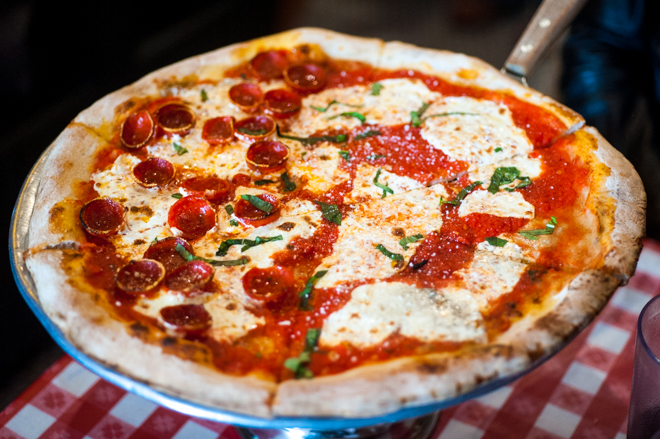 [Lombardi's]
[Lombardi's]
Lombardi's thrived in Little Italy, feeding legions of factory workers and immigrants longing for a taste of home. It was so popular that Lombardi soon dispensed with the groceries entirely and started selling pizza exclusively. Numerous employees struck out on their own, fanning out across the city and spreading the distinctive style of pizza.
In 1924, Lombardi's employee Anthony "Totonno" Pero opened Totonno's in Coney Island. Five years later, John Sasso, also an employee of Lombardi's, opened John's Pizza on Bleecker Street. 1933 saw Pasquale "Patsy" Lanceri, reputed to have been a Lombardi's employee, open Patsy's in Harlem. Lombardi's, John's, Totonno's, and Patsy's are all still around today and represent cornerstones of the original NY style of pizza. (Lombardi's closed in 1984 and reopened a decade later in a different space on the same block.)
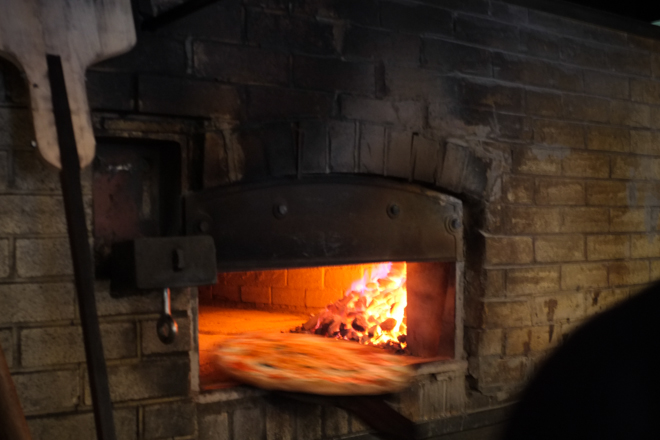 [The coal oven at Grimaldi's]
[The coal oven at Grimaldi's]
Others followed suit serving this particular form of pizza. Arturo's on Houston Street opened in 1957 and remains a largely unblemished example of the breed, not having caught on with the tourists who these days flood nearby Lombardi's and John's. Lanceri's nephew Patsy Grimaldi opened Grimaldi's in Brooklyn in 1990. He had hoped to open in Manhattan, but by this time there was a ban on the use of the coal fired ovens that produce the intense heat and characteristically sooty crust of the Neapolitan-American style. He was forced to look for a grandfathered space in Brooklyn, which is the only way to use a coal oven within city limits these days. Luzzo's in the East Village was lucky enough to find such a space when it opened in 2005, inspiring what the owners dubbed "coal oven Neapolitan," an amalgam of Neapolitan and Neapolitan-American styles.
 [A gas powered pizza oven]
[A gas powered pizza oven]
The ban on coal ovens fundamentally changed the nature of pizza in NYC by forcing pizzerias to use other methods, of which gas ovens proved by far the most popular. This led to a democratization of the pizzeria by virtue of the lower costs associated with using prefabricated gas ovens, which by the post WWII years had become comparatively affordable vis-à-vis building a dedicated brick structure. But the postwar years also saw pizza breaking out of its "ethnic" designation, as returning GI's sought to satisfy the taste they had acquired for Italian pizza while liberating Europe. Soon, pizzerias where opening in neighborhoods all over the city, not just Italian American ones.
NY Style Pizza
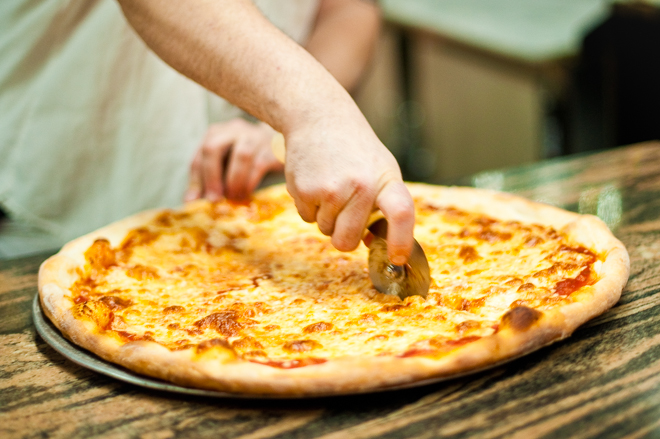
The most common and now quintessential form of NY pizza has thus become the type that is cooked in gas ovens rather than the Neapolitan-American type cooked with coal. NY style pizza is sold either as whole pies or by the "slice" — a triangular wedge cut from a whole pizza. Typically, an 18" NY pizza yields eight slices. With the exception of Patsy's, none of the original coal oven pizzerias sell pizza by the slice. The availability of slices of pizza fundamentally changed the nature of pizza in NYC, liberating it from the restaurant and substantially lowering the financial barrier of entry. NY style is virtually defined by the low cost of entry, the immediacy of service, and the portability of the product.
The NY style pizzas tend to have far more cheese than Neapolitan-American coal oven pies. The cheese typically covers the entire pie, with sauce only poking out along the circumference. A low moisture mozzarella is used rather than fresh mozzarella, which is not well suited to the lower temperature and longer cooking times of the gas ovens. Gas fired pizza lacks the sooty exterior that is a hallmark of coal fired ovens, but it still has plenty of crunch and snap to go along with the pliancy and springiness of the dough.
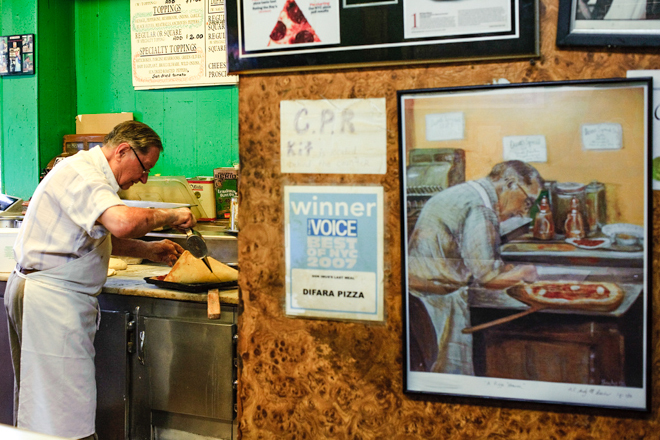 [Dom DeMarco, Di Fara]
[Dom DeMarco, Di Fara]
In their purest form, NYC pizzerias will sell only pizza. Of course, many shops long ago added hero sandwiches and pasta dishes to their existing pizza menus, and later still wraps and even juices. These types of establishments might not have the culinary bona fides of the dedicated pizza joints, but they certainly serve a valuable function in many neighborhoods and any independent, locally owned NY pizzeria stands as a bulwark against a fast food joint or national chain store.
At its best, of course, a local pizzeria transcends the neighborhood and becomes a destination for diners. There is perhaps no greater example of this than Di Fara in the Midwood section of Brooklyn. It is run by Dom DeMarco who is as close to sainted as a pizzaiolo can be, and he has been slinging pies since 1961. But there are numerous others classic NYC style pizzerias that are worth a trip such a Joe's in Greenwich Village, Joe & Pat's on Staten Island, Lou & Ernie's in the Bronx, Rose & Joe's in Queens, and Sal & Carmine's on the Upper West Side, to name but a few.
Sicilian
 [A sicilian slice from Joe's Pizza]
[A sicilian slice from Joe's Pizza]
In addition to the classic round pizza, most every pizzeria also sells Sicilian style pies and slices. Characterized by a rectangular shape due to being pan cooked, with a crust that is generally over an inch thick, this style of pizza originated in the bakeries, not the pizzerias, of Sicily, where it is sold as Sfinciuni. In Sicily, Sfinciuni is topped with a tomato sauce spiked with anchovies and onions under a canopy of breadcrumbs rather than the tomato sauce and cheese we see in NYC. That latter recipe is the result of the American melting pot effect of throwing Neapolitans and Sicilians together into lower Manhattan. You can find a version of Sfinciuni sold at Prince Street Pizza as the Broadway Breadcrumb and also at Famous Ben's as the Palermo slice. Some of NYC's most storied pizzerias specialize in square slices like L & B Spumoni Gardens in Brooklyn and Rizzo's in Astoria, Queens.
Local Chains
Inevitably, the culture of small local pizza parlors succumbed to the expansionist impulse and someone decided to branch out and open a second location and then a third and so on. The most famous chain is probably Ray's, although here we are talking about several competing entities and a story which has a tangled and confusing history. The truly excellent original and now defunct Ray's, which was located on 59 Prince Street and dated back to 1959, spawned a slew of imitators such as Ray Bari, Original Ray's, Famous Original Ray's and World Famous Ray's. It got to the point where there was practically "a Ray's on every corner," as the old adage went, and the whole affair devolved into self parody as they tried to top each other with lawsuits and publicity stunts and by adding more cheese and thicker crusts to their recipes.
Aside from the various Ray's, there are a number of local chains such as Bravo, Famous Famiglia, and Abitino's that sell pizza by the pie and slice. They represent the middle ground of NYC pizza — workaday pies that offer solid value for money, if not the most inspired expressions of the art.
Patsy's is probably the most storied name associated with a chain, but you should know that it is the result of a licensing deal and that the pizza sold at the East Harlem original is quite different from the various Patsy's outposts that dot the city. The most recent chain to expand significantly is Artichoke Basille's, which introduced the artichoke slice from the founders' native Staten Island to the denizens of Manhattan with great success.
Food Trucks
 [Valducci's Pizza truck]
[Valducci's Pizza truck]
Not surprisingly, pizza is well represented when it comes to food trucks in New York City. One can find everything from a $1 slice all the way up to a fancy Neapolitan pie. Pizza trucks actually anticipated the current food truck fad by several years. Midtown regular Jiannetto's got rolling in 1998, and Valducci's claims to have been in operation since 1999. Both pizza trucks can still be found on city streets. The Neapolitan Express pizza truck will soon open a brick and mortar location.
The $1 Slice
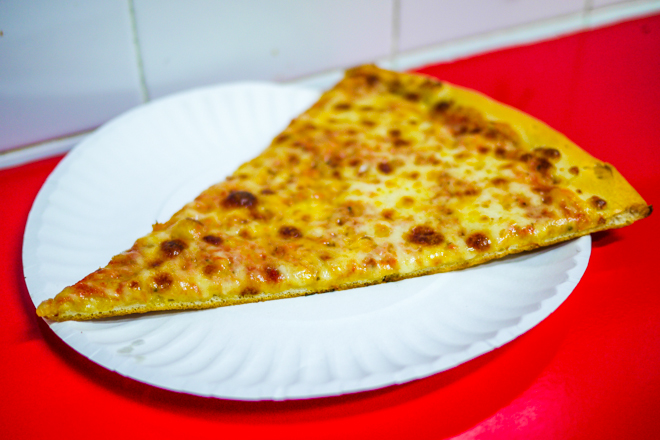 [A $1 slice from Krust Pizza]
[A $1 slice from Krust Pizza]
The $1 slice has had an undeniable impact on the budget dining scene in NYC, especially in recent years. It has certainly eclipsed the beleaguered hot dog as the indigenous budget street food of choice. The era when a hamburger could be found at such a low price outside of a fast food chain is long gone and Halal street carts have become the dominant form of street food actually sold on the street.
The slice purist will scoff at the quality of the pizza at the $1 joints, which is inexorably compromised by virtue of their price point. Qualitative issues aside, the pizza sold at these $1 slice joints is still in the NY style. And sometimes it is hard to argue with the free market. The fact is that a kid with a $1 to spend on food is choosing between $1 slice and a dollar menu at a fast food joint, not necessarily the neighborhood pizzeria offering a top notch slice for $3.
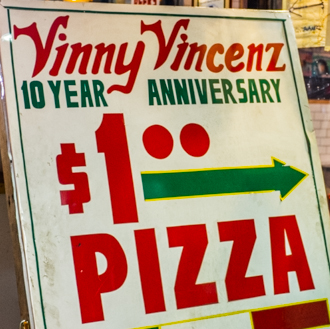 Of course in some cases the $1 slice has forced higher priced competitors to lower their prices in order to compete. Take Vinny Vincenz on First Avenue for example. Before Artichoke opened around the corner, it was the darling of food bloggers and pizza lovers in the area. The overnight success of Artichoke and then the opening of a Two Bros. pizzeria next door and a Percy's Pizza across the street, both offering $1 slices, forced Vinny Vincenz to follow suit. Even the local Papa John's franchise situated down First Avenue now offers $1 slices.
Of course in some cases the $1 slice has forced higher priced competitors to lower their prices in order to compete. Take Vinny Vincenz on First Avenue for example. Before Artichoke opened around the corner, it was the darling of food bloggers and pizza lovers in the area. The overnight success of Artichoke and then the opening of a Two Bros. pizzeria next door and a Percy's Pizza across the street, both offering $1 slices, forced Vinny Vincenz to follow suit. Even the local Papa John's franchise situated down First Avenue now offers $1 slices.
Bar Pizza
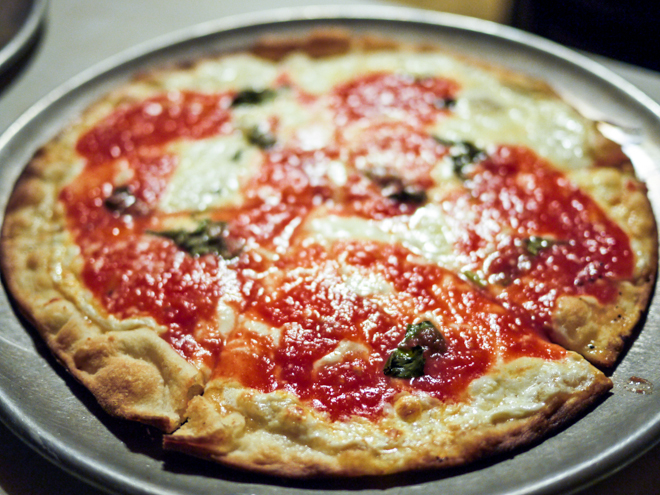 [A bar pie from Lee's Tavern]
[A bar pie from Lee's Tavern]
Characterized by a thin, crisp crust and most often cooked in gas ovens in the back kitchens of bars, this type of pizza is not especially prolific in the city, at least compared to the slice joints. It is similar in form and substance to Midwestern pizza (see below) and it's more popular in other states. Lee's Tavern on Staten Island, which dates back to 1940, serves a notable bar pie.
Neapolitan
 [A Neapolitan pie being made]
[A Neapolitan pie being made]
The most significant trend in New York City pizza in recent years has been the proliferation of the Neapolitan style. While the notion of ascribing "authenticity" to food is a tenuous one at best, there is ostensibly a standard that can be met in terms of Neapolitan pizza. The Verace Pizza Napoletana Association (VPN) is an Italian organization that certifies restaurants based on the employment of wood fired ovens and the use of a list of standardized ingredients of Neapolitan origin, such as 00 flour, San Marzano tomatoes, and buffalo mozzarella.
The first VPN certified establishment in NYC was La Pizza Fresca, which opened 20 years ago and is still going strong. Additionally Ribalta, Via Tribunali, and Naples 45 all hold VPN certification. But there are arguably higher expressions of the form beyond these restaurants. Una Pizza Napoletana, which has since relocated to San Francisco, really raised the stakes in terms of attention to detail, and some would say militancy, in recreating the original pizza of Naples using an imported oven and ingredients. Many Neapolitan pizzerias followed suit, most notably Motorino, Keste, and Don Antonio by Starita.
Roman
 [Pizza al taglio]
[Pizza al taglio]
When discussing Roman pizza, we are really talking about two distinct forms — the vanishingly thin pies generally cooked in wood fired ovens and served in sit down restaurants, and the pizza al metro (pizza by the meter) also known as pizza al taglio (pizza by the cut), which is sold both in bakeries and dedicated shops in the Italian capital.
The former is perhaps best represented by Gruppo, Posto, and Vezzo, which comprise a mini-chain of pizzerias that offer very thin, crisp crusts. They are similar structurally to Roman pizza although many of the toppings these pizzerias sell are distinctly American, such as ham and pineapple. The pizza al metro is well represented around town, most notably at Sullivan Street Bakery, which serves versions of pizza bianca (a hand stretched bread) and pizza pomodoro that would be the envy of most any Roman baker.
Cajun Pizza
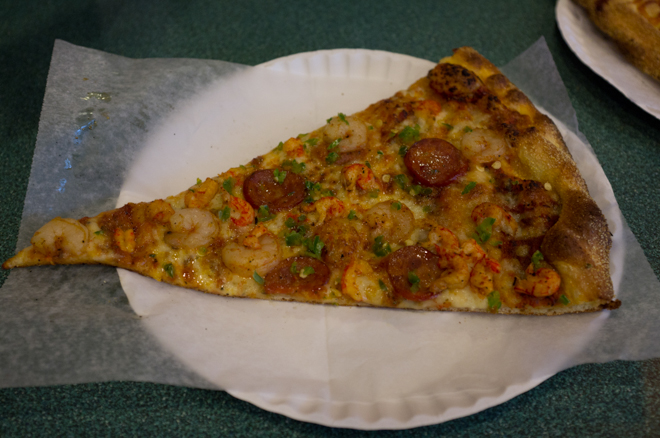 [The bayou beast from Two Boots Pizza]
[The bayou beast from Two Boots Pizza]
Cajun pizza is actually a New York City creation courtesy of the Two Boots chain, which started off in the East Village in 1987 as a full service establishment. The conceit of the restaurant was that it was a fusion of the cuisines of Louisiana and Italy, but what emerged was something uniquely New York. By combining cornmeal crust, a spicy tomato sauce, and unexpected toppings (crayfish anyone?), Two Boots built a chain that now spans the nation but still retains some of the quirkiness of the East Village original.
Deep Dish
If there is a style that sits in direct antithesis to the NYC street slice, it is assuredly the deep dish pizza that originated in Chicago. There is of course a famous rivalry between the two forms that often explodes into the popular zeitgeist, on talk shows and across the Internet. Many New Yorkers do not even consider the Chicago form to be pizza at all, dismissing it as a casserole. It has not made significant inroads in New York City. This is true even when factoring in Pizzeria Uno, the Chicago deep dish chain (now called Uno Grill and headquartered in Boston), which has been operating in NYC for a few decades. The now defunct Big Nick's on the Upper West Side sold a version that wouldn't convince anyone to switch allegiances and you sporadically see them pop up on random menus at restaurants like L'asso, with Emmett's being the most recent entrant.
Midwestern Pizza
 [Nicoletta]
[Nicoletta]
Distinct from Chicago deep dish, much of the pizza sold in the Midwest, including in Chicago, is actually quite thin with a crisp crust and a blanket of cheese and sauce. It is generally cut into squares, rather than wedges, which is referred to as a "tavern cut" or "party cut." Nicoletta in the East Village is one of the few example of the style, although the pizza is cut into wedges as is the local custom in NYC. The now shuttered Pulino's on the Bowery was notable in that it served a tavern style cut pizza.
St Louis Style Pizza
This form differs from other Midwestern style pizza because it most often uses Provel, a processed cheese made of cheddar, Swiss, and provolone that was created in St. Louis decades ago. Speedy Romeo in Brooklyn serves just such a pie.
Grilled Pizza
Grilled pizza was invented at Al Forno in Providence, Rhode Island, in 1980. There have been some limited explorations of the form in NYC. The late Vincent Scotto sold a version at the now shuttered Gonzo in Greenwich Village and before that at Fresco by Scotto, which continues to offer it on the menu. Coals, a dedicated grilled pizza restaurant, had an outpost in the Bronx that is now shuttered, but another location is still open in Westchester.
California / Flatbread / "Chef" Pizza
California style pizza was invented in 1980 by the late Ed LaDou, and it was popularized by Wolfgang Puck. The form is essentially the extension of the California cuisine ethos of using fresh, seasonal, and local produce into the realm of pizza. Suddenly words like "seasonality" and "local" and even "low fat" entered the pizza lexicon. The form found mass appeal with the California Pizza Kitchen chain, that currently operates two locations in NYC. But the notion of applying market ingredients and culinary technique found higher expression in the kitchens of NYC where places like the now defunct Zoe and the still-going-strong Mercer Kitchen started selling this type of pizza in the 1990s. More recently we have seen an explosion of so called flatbreads on menus across town.
New Brooklyn Pizza
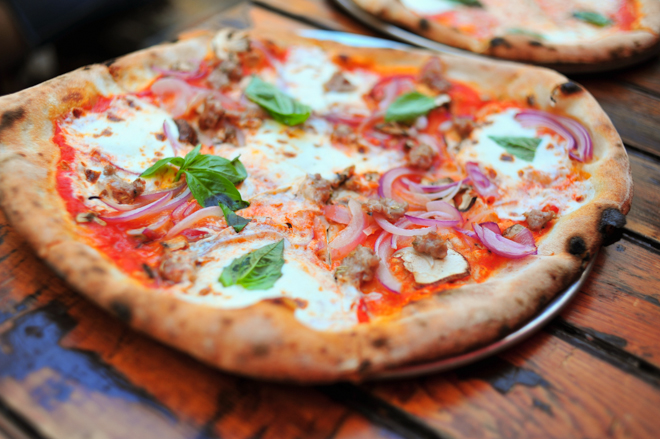 [Roberta's]
[Roberta's]
For lack of a better term, this category describes a particular aesthetic that is not characterized by any one pizza style as much as a dedication to inventiveness and using top quality, and often local, ingredients. The most obvious contributors to the form are Franny's and Lucali, later joined by Roberta's, and later still Paulie Gee's. One could also include less lofty operations such as Best Pizza, Pete Zaaz and Williamsburg Pizza to the roster.
National Pizza Chains
Despite a wealth of vastly superior indigenous alternatives, chain pizzerias still exist in NYC. Pizza Hut, Dominos and Papa John's all have numerous locations throughout the boroughs, although commendably Staten Island, arguably the most suburban of the city's boroughs, has the least number of chains. While there are indeed distinctions between the pizza sold at the various chains they can be conveniently lumped together as a single style because they exist as much as a result of market research and analysis as through any great love of craft.
What's missing?
As we have shown, New York City has a rich pizza culture, one that is unparalleled in terms of diversity of form and proliferation of pizzerias. Pizza may have started in Naples but NYC may just be the epicenter of the art. There are, however, a few types of pizza that you won't find in NYC:
Trenton Tomato Pie
The longest continuously operating pizzeria in America is Papa's in Trenton, NJ which has been open since 1912. (Although Lombardi's preceded it by several years, it closed for a decade in the 1980's ceding the title to Papa's.) A "tomato pie" is for all intents and purposes a round pizza although one in which the cheese goes down first and is then topped by the sauce. While you find this practice in NYC, notably at L&B Spumoni Gardens in Brooklyn and any place serving a Grandma slice, there is no establishment selling a round version of a Trenton tomato pie.
New England
 [A New England style pizza]
[A New England style pizza]
Often called Greek or Diner style because it proliferates in the diners across New England, many of which are owned by Greek immigrants, this style is sort of a reconciliation of the Chicago and NY forms. It is cooked in oiled pans but is not as deep as Chicago pizza such that it can be served in wedges and eaten by hand if necessary. The closest version we know of is sold at the Mamaroneck Diner in Westchester.
New Haven
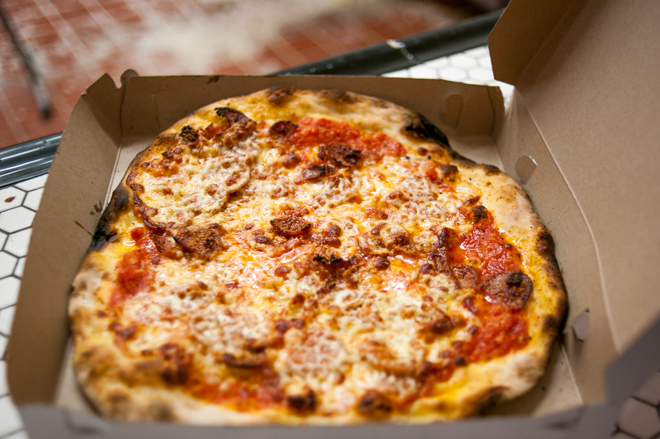 [Frank Pepe]
[Frank Pepe]
One of the most revered forms of American pizza originates in New Haven, CT. The style shares much in common with the Neapolitan-American style. The pies are cooked in coal fired ovens giving them the same charr and they are sold as whole pies rather than by the slice. They differ in that they tend to be more irregularly shaped, more oblong than round, and are drier, with far less cheese. The closest restaurant that serves this type of pizza is Frank Pepe Pizzeria Napoletana in Yonkers, NY.